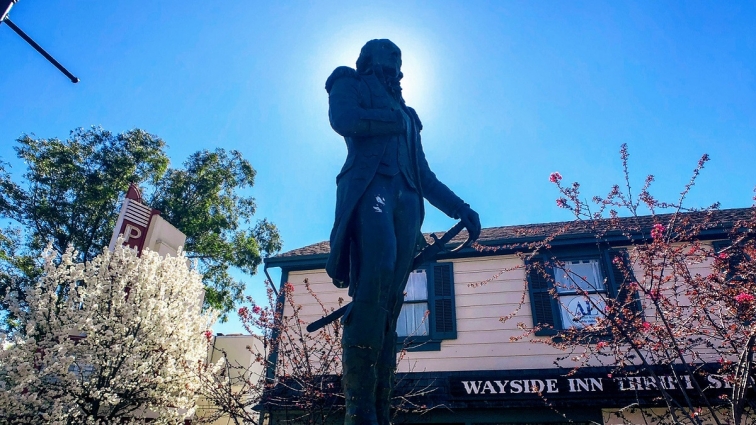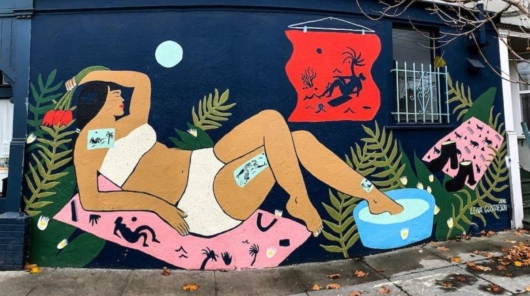
BARTable Walk: Lafayette to Orinda
Last Updated On May. 11, 2020
When:
Enjoy on a nice day
Where:
3601 Deer Hill Road
Lafayette, CA 94549
United States
BART Station:
LafayetteWalk Time:
3.5 hoursEditor's note: Due to COVID-19, please note that some trails, restaurants, and theaters are closed or have limited operating hours.
Tucked between the East Bay hills and Mount Diablo are two cities that have created vibrant, walkable downtowns and kept their family-friendly, rustic charm. But don’t take our word for it. Find out for yourself on this BARTable Walk from Lafayette to Orinda.
Walk Time: 3.5 hours | Distance: 7.0 miles | Terrain: Sidewalks, paved & dirt trails, street shoulders
Route Map
Head out of the Lafayette Station through Exit B (opposite the main parking lots with solar panels). Take the stairs down to the smaller lot and go left to connect with the paved pathway to the downtown area. Pass to the right of the steel “Shadow” sculpture by Ben Trautman (Can you see the old tree trunk?) and wind your way down to Mt. Diablo Blvd., Lafayette’s main drag and business backbone.
Hang a left and walk a couple of blocks to Oak Hill Road and cross to the other side. If it’s before 2:30pm, take a left and head up to Millie’s Kitchen. This “Lamorinda” (Lafayette, Moraga, Orinda) institution has been serving up breakfast and lunch since 1975 when original owner and chef Millie Harris first opened the front door. Inside is like Grandma’s place with its homey décor and cozy atmosphere. Join the tables of families, friends and local workers and order up one of these house specialties: corned beef hash benedict, huevos rancheros, Belgian waffles or French toast (open daily, 5:30am to 2:30pm).
A mug of good ol’ fashioned drip coffee with a slice of fresh coffee cake at Millie’s Kitchen is the perfect combo to get the day started on the right foot.
Go back down to Mt. Diablo Blvd., cross over and walk left to Elam and Margaret Brown (aka Lafayette) Plaza. Especially on those sunny inland East Bay days, folks flock to this small park to picnic, catch up, read or just people watch. Around the plaza are a few landmarks to check out. Under the east pergola is a stone from the Grist Mill built in 1853 along the nearby creek by the Browns (who also donated the land for the plaza). To the side is a statue of Lafayette or more precisely, Marie-Joseph Paul Yves Roch Gilbert du Motier, Marquis de La Fayette. He was the famous French general who fought in our Revolutionary War and, of course, for whom the city was named. Just behind the statue is the Park Theater that’s currently shuttered, but first opened in 1941 with a showing of Abbott and Costello’s Hold That Ghost.
Lafayette Plaza is the venue for some of the city’s top events, such as Rock the Plaza and the Lafayette Art, Wine & Music Festival.
Continue past the theater and take a right onto First Street. Stroll through this neighborhood of cute homes down to School Street, cross to the other side and head right to the Town Hall Theatre Company at Moraga Road. This troop started out as the Dramateurs in 1944 and is the oldest continuously active theater company in the county. With more than 300 productions under their belt, they’ve put on everything from Romeo & Juliet and Our Town to A Few Good Men and The Rocky Horror Show. The wood-shingled structure itself was built on land and with labor donated by the community. Opening in 1914 with a grand ball, Town Hall events were so popular that the Sacramento Northern Railroad ran a special line to bring in revelers from their Oakland station (Box Office Hours: Tuesday to Friday, 4-6pm; Saturday, 2-4pm).
Besides theater productions, Town Hall has held church services, community meetings, movie screenings and even basketball games.
From the corner, cross over to the other side of Moraga Road and head to the right. At the Art and Science of Eyewear store, take a left down the side street, through the parking lot and across Lafayette Circle. Then fasten your epicurean seatbelt and step into Amphora Nueva for a ride into the wonderful world of extra virgin olive oils. This family-owned and operated company has been in the olive oil industry close to 100 years and directly sources all of their 80+ products, some of which they produce themselves. The enthusiastic and highly knowledgeable staff is raring to answer any questions you might have about oils and vinegars as well as share pairing and recipe ideas, like white balsamic vinegar spritzers! They are heavenly, trust us (open daily, 10am to 6pm).
Don’t be shy! Amphora Nueva encourages sampling everything in their store from the extra virgin and infused olives oils to the white and dark aged balsamic vinegars.
Double back to Lafayette Circle and walk left up to Mt. Diablo Blvd. Take a left again at the Roundup Saloon, another local institution that’s been pouring drinks and “Keeping Lafayette Real Since 1935,” and continue through downtown. Cross over at Dolores Drive and keep going down Mt. Diablo Blvd. for a look at the Lafayette Veterans Memorial Center.
On the outside of the Lafayette Veterans Memorial Hall is a wall of bricks honoring members of the armed forces who served in wars and conflicts around the globe.
At Risa Road, cross back over to the other side of Mt. Diablo Blvd. and keep walking to the right. Make sure you stop and check out what’s beneath your feet. Notice how it doesn’t look like any ordinary sidewalk? That’s because it was made with pervious paving material that lets rainwater soak into the ground instead of running off down the gutter. This way, the water is naturally filtered and replenishes the soil moisture.
Though pervious paving material costs more, it reduces erosion and stormwater flow into the adjacent creek – not to mention helps keep the path lush and green.
At the entrance sign to the Lafayette Reservoir, tighten your laces and hike up the paved trail (1/3 mi) to the parking lot. Completed in 1933, the reservoir is not only a bank account of 1.4 billion gallons of water but also the local go-to spot for walking, hiking, boating and picnicking. The two main structural features are the dam (on top of which is the parking lot) and the observation tower in the lake. If you’re wondering why the tower is so tall, while the dam was being constructed, the foundation underneath began to shift under the weight. Engineers scrambled and came up with a new design that scaled back the reservoir to one-third of the original plan, but by then the tower had already been built (open daily, hours vary by month, check their website; free admission).
Back in 1975, there were reports of a 6 to 8-foot alligator in the Lafayette Reservoir. A search was mounted for the “Beast of Lafayette Lake,” but it was never found!
Retrace your steps back down to Mt. Diablo Blvd. and continue the walk to the left. Keep an eye on the hills for “rafters” of wild turkeys strutting about. At Acalanes Road, cross over and turn up to the left then take a right onto Hidden Valley Road. Heads up! There are no sidewalks on this stretch (1/2 mi) so be extremely alert and careful walking down the shoulder (right side recommended). Where the road bends to the left, jump onto the dirt trail and take it up to St. Stephens Drive into Orinda. Cross over and continue down St. Stephens Trail that parallels Highway 24.
Alternatively, to avoid busy Hidden Valley Road, after turning onto it from Acalanes Road, make a quick left onto Knox Drive, then turn left on Sherwood Drive, then turn right on Tahos Road, then turn left on Bates Boulevard and follow that to its end.
At the end of the trail and Bates Blvd stands the de Laveaga Train Depot. Built in the 1890s, it is the only station left of the California & Nevada Railroad line that ran from Emeryville bringing passengers to the “countryside” for getaway weekends. The C&N had planned to extend the line through the Sonora Pass to Bodie in the Eastern Sierra and out to Colorado, but due to lack of passengers and money, the railway closed in 1904. The building was moved from its original spot near Miner Road to the de Laveaga family’s property before being donated to the city in 2000 and then restored and relocated to its present location.
The uniquely curved roofline of the de Laveaga Train Depot, reminiscent of a pagoda, has led local historians to believe it may have been built by Chinese laborers.
Keep on going, passing in the front of the gas station and turning the corner onto Moraga Way into downtown. Cross over to the Orinda Theater that opened in December 1941 just a few weeks after the attack on Pearl Harbor. It was built by local developer and movie buff Donald Rheem who was also the son of William Rheem, President of the Standard Oil Company (we know it today as Chevron). The theater’s interior is flush with original art deco features and murals representing air, fire, water and earth by Anthony Heinsbergen. The building was flagged for demolition in 1984, but fortunately saved by the community and reopened in 1989. Today, the theater features new-release movies, classic films, live concerts and performances, film festivals and more.
If you’ve ever passed through Orinda on BART, chances are you have looked out the window at the Orinda Theater’s signature marquee to see what’s playing.
By now, you surely have worked up an appetite so carry on to the left to bookend your walk with a bite at one last local institution, Europa Haufbrau. This family-run restaurant has been serving up carved-to-order roasted meats for over 25 years. Grab a tray and make your way down the line building your own “meat and two veg” plate. It’s all classic comfort food – corned and roast beef, pastrami, baked ham and roasted turkey with all the trimming options. Dig in and let the kiddos burn off any remaining energy on the indoor play structure or video games (open Monday to Saturday, 9am to 9pm; Sunday, 9am to 8pm).
Besides the carved meat selections, check out Europa’s Daily Special menu for other classic dishes, such as meatloaf, stuffed cabbage, beef Stroganoff and Salisbury steak.
To finish up the walk, go back down Moraga Road, cross over and take a left down Brookwood Road. Turn right onto Camino Pablo and go under Highway 24. On the other side, take a left up to Orinda Station.
Variations and options
- Extend the walk: Include the gentle and paved Lakeside Nature Trail loop at the Lafayette Reservoir (add 1.5 hours/2.7 miles) or the challenging 4.7-mile Rim Trail that rings the surrounding hills.
- Take a walking tour: Sign up for Local Food Adventure’s Eat Stay Love Lafayette Food Tour for a progressive eating-style lunch with demos and local history. To see more public art, follow this self-guided Lafayette Public Art Walk.
-
Hang around: But wait, there’s even more! Find out what to do in Orinda.
What to bring: Sturdy walking shoes and a daypack with water, bag lunch or snacks (or pick up along the way), sun protection (hat, sunscreen), extra layers or rain gear (just in case). A smartphone is handy for maps and looking up information or taking photos. And, of course, your Clipper Card!
About the stations
Lafayette Station first opened in May 1973. It sits in the median of Highway 24 and consists of a single island platform. The entrance lobby features three columns tiled with multi-colored mosaics designed by Helen Webber and built by Alfonso Pardiñas. Visible from the platform to the northeast is the Lafayette Hillside Memorial, a collection of markers commemorating soldiers who died in the Iraq War and the War in Afghanistan.
Orinda Station first opened in May 1973. It is the first station on the east side of the Berkeley Hills Tunnel. In the entrance lobby is a full-height, abstract mural of geometric shapes in orange, red and black by San Francisco artist Win Ng. On the outside of the station is another mural of Orinda historical sites based on a painting by local artist Loni Bee and commissioned to honor the nation’s Bicentennial.






